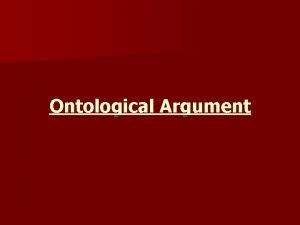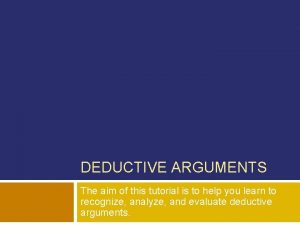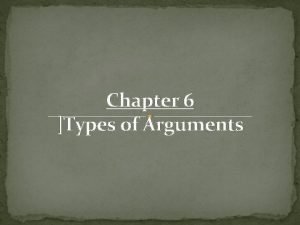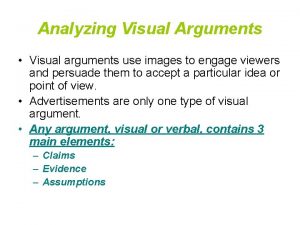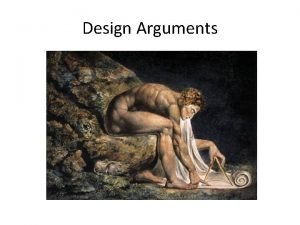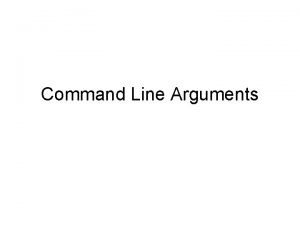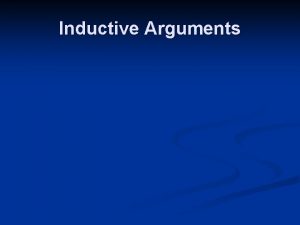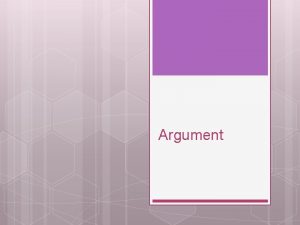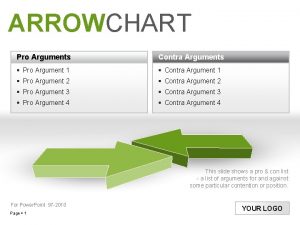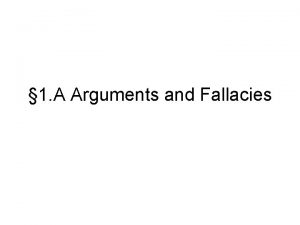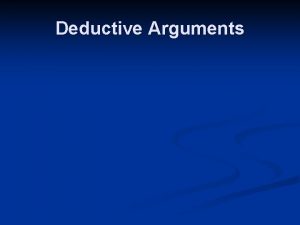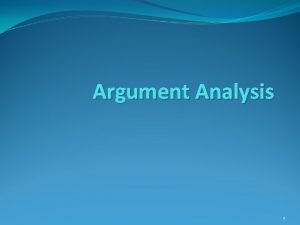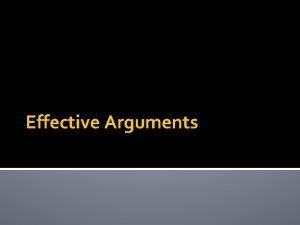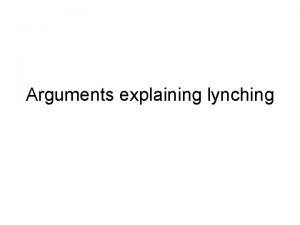The Nature of Arguments Argument FieldsSpheres vs Types














- Slides: 14

The Nature of Arguments � Argument Fields/Spheres vs. Types ◦ Spheres/Fields – Contexts in which arguments are made that influence what counts as evidence, burden of proof, etc. ◦ Types – The logical assumptions embedded in an argument, e. g. , causal, generalization, authority, etc. � Assumptions ◦ All Spheres Require “Reasons” To Justify Claims ◦ Argument Types Are Common Across Spheres ◦ A Single Model Can Be Used To Analyze Arguments Across Spheres

The Toulmin Method � � Stephen Toulmin is a philosopher who has contributed a lot to the study of argument. Toulman teaches others to properly analyze the logic of any argument, including your own. The Toulmin Method requires analysis of the argument’s claim, the claims supporting reasoning and evidence offered to support the claim. Identify the Claim (what does the writer want us to believe) Look for Qualifiers (“typically”, “usually”. “most of the time”) Find the Exceptions (in what circumstances would the writer not stand behind their claim) Summarize the Claim Analyzing the Reasons (make a list of reasons supporting the claim) Examine the Reasons ( do the reason make a strong foundation, is the reason relevant ) Analyzing the Evidence (Make a list of evidence provided, consider the supportive evidence and its weight) � Examine the Evidence (credibility) � Note Refutations (What refutations does the writer offer ? Summarize them. How does the writer approach each objective? ) � Summarize Analysis (Always a good idea to summarize your position) � � � �

The Toulmin Model Qualifier Grounds Warrant Claim Backing Reserv -ation Backing Rebuttal

The Toulmin Model Grounds Warrant Qualifier Claim Warrant Reserv -ation Backing Rebuttal

The Toulmin Model Grounds Warrant Qualifier Sub. Claim Reserv -ation Backing Rebuttal

Some Cautions about Toulmin Model � Arguments don’t naturally occur in this order ◦ Arguments don’t always begin with evidence ◦ Arguments don’t always include all the parts, some are implied ◦ Arguments will have a unique configuration of warrants, claims, backing, etc. ◦ One paragraph, speech, letter to the editor, etc. is likely to have several arguments. ◦ Modeling an argument is an act of interpretation

Rising to the Occasion of Our Death This story discussed the debate of voluntary euthanasia and the controversial view points people have upon this subject. (whether it should be a right of the people or not) � Rising to the Occasion of Our Death Context: Terminal ill patients should be allowed to die, but the death policy should not be used regularly for mercy. � Reasons: The author (William May) points out both the pros and cons to voluntary euthanasia. This story makes you see the subject as grey, rather than black and white. It is a complicated question, so his reason to meet on some type of compromise to please both sides, makes plenty of sense.

Rising to the Occasion of Death (short story) � Active voluntary euthanasia (killing for mercy) � Should we kill the terminally ill if they are suffering? A. Anti-Voluntary Euthanasia: -Murder is wrong, regardless of the patients circumstance. -Possibly push elderly people into euthanasia, pushing people to death. B. Pro-Voluntary Euthanasia: -Ending someone's misery -Avoiding limitless grief C. The Writers Claim: Meets in the middle by saying, “ a country has not earned the moral right to kill for mercy unless it has already sustained and supported like mercifully” (p. 33).

Analyzing the Evidence When Analyzing Evidence of a Script: � List the Evidence ( data, citations, case studies, the facts, etc. ) � Examine the Evidence ( Is the evidence legitimate or accurate; estimate the adequacy and relevance of the evidence) � Noting Refutations - refutation occurs when writers are preparing for potential objections to their position. The writer will attempt to undermine the basic argument and knock out the obvious objections to the claim. What refutations does the writer offer? How does the writer approach each objection? � Summarizing Your Analysis -After your analysis, it’s a good habit to summarize your results in a conclusion paragraph. Restate your main points and occlusion(s).

Elements of Argument � Claim ◦ The position for which you are seeking adherence � Ground ◦ A statement made about persons, conditions, events, or things that says support is available to provide a reason for a claim � Warrant ◦ A general statement that justifies using the grounds as a basis for the claim, i. e. , identifies the argumentative logic

Elements of Argument � Qualifier ◦ A statement that indicates the force of the argument, i. e. , “How much is being claimed? ” � Rebuttal ◦ The basis on which the claim will be questioned, i. e. , governs how much and what type of support or qualification is required � Reservation ◦ A statement of conditions under which the claim would not apply, i. e. , often elaborates the qualifier

Types of argument � Generalization (rhetorical induction) ◦ Assembling similar instances to show a general principle � Cause ◦ Cause to effect – grounds are the claim’s cause ◦ Effect to cause – grounds are the claim’s effect � Sign ◦ Similar to cause, but focuses on correlations or cooccurrence instead of causal relation. � Analogy ◦ Literal and Figurative � Authority ◦ Expertise ◦ Lack of Bias ◦ Bandwagon fallacy

Types of Argument and Diagramming � Argument types occur across a range of fields � The labels identity the common topoi, or tropes, that guide argumentation � After you identify the warrant in an argument (implied or explicit) you compare it to these types of arguments in order to name the warrant.

Definitions as Arguments � Arguing over definitions helps ensure that “what is being argued about” is agreed on. ◦ For example, what do we mean when we say we want to have a debate about the “public good” � Types of definitions ◦ Formal – locates a concept in a class and then differentiates it ◦ By Example- define unknown ideas by relying on previous knowledge ◦ Functional Definition – illustrate how a concept functions ◦ By Analogy – compares characteristics. Unlike formal definition, it relies on similarity rather than membership in a class. ◦ By Authority – utilizes usage, etymology, and the intent of wordsmith’s to define a term or concept
 Ontological argument
Ontological argument Types of inductive reasoning
Types of inductive reasoning Standard form argument
Standard form argument 6 types of arguments
6 types of arguments Types of arguments in philosophy
Types of arguments in philosophy Visual argument images
Visual argument images Nature and nature's law lay hid in night meaning
Nature and nature's law lay hid in night meaning Nature nature controversy
Nature nature controversy Different types of argument
Different types of argument Hình ảnh bộ gõ cơ thể búng tay
Hình ảnh bộ gõ cơ thể búng tay Slidetodoc
Slidetodoc Bổ thể
Bổ thể Tỉ lệ cơ thể trẻ em
Tỉ lệ cơ thể trẻ em Voi kéo gỗ như thế nào
Voi kéo gỗ như thế nào Thang điểm glasgow
Thang điểm glasgow
